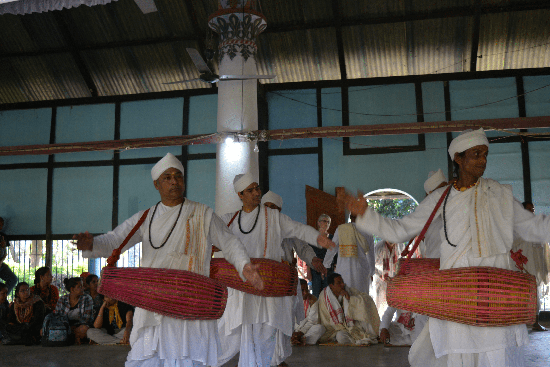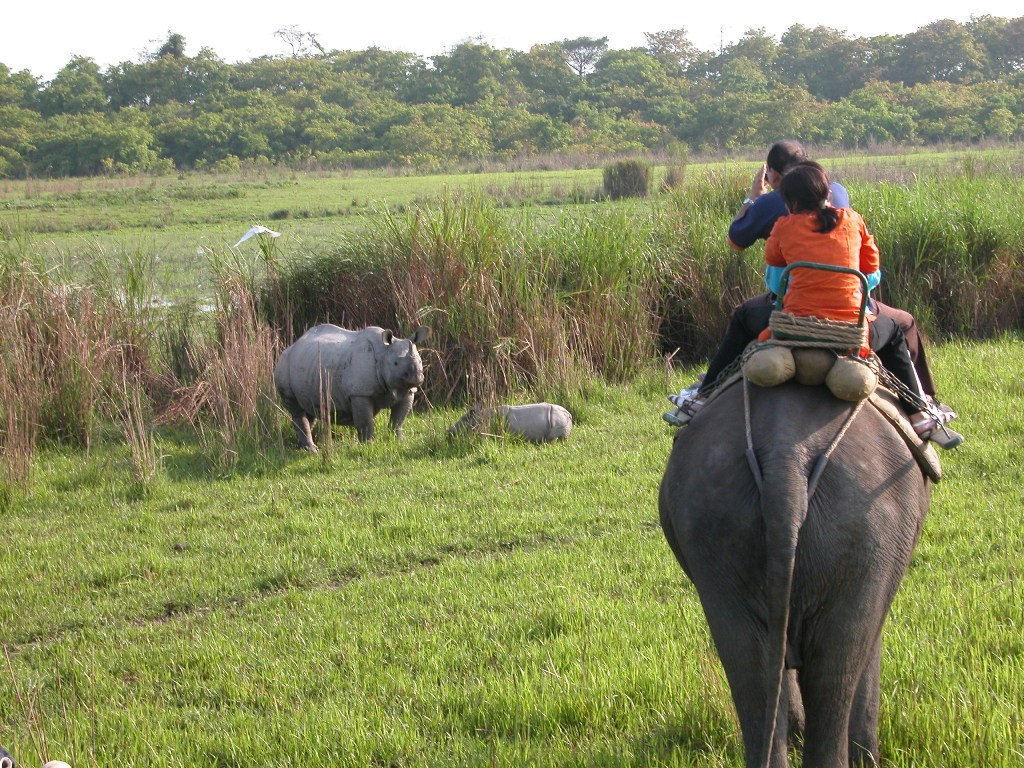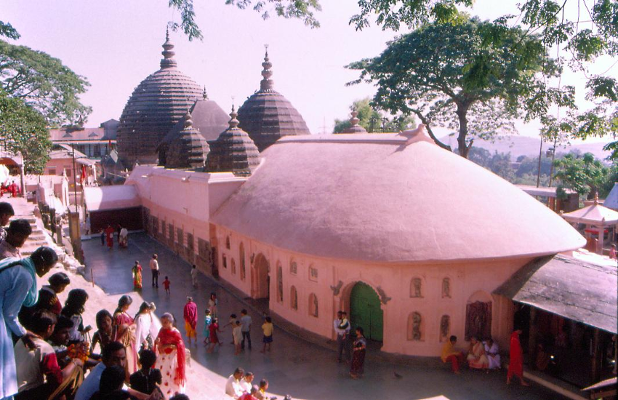- +91 9435637641 / 7099895338
- moc.yrevocsidivrup@yrevocsidivrup
- Purvi Gallery
- Guest Comment
Assam is synonymous with unspoiled natural beauty, teeming wildlife, immaculate tea gardens and warm, beautiful people. It’s a strategic location in the northeast of India, and it’s accessibility from the rest of the country makes it the gateway to the northeastern states. It shares borders with Meghalaya, Arunachal Pradesh, Nagaland, Manipur, Tripura, Mizoram and West Bengal: and has National Highways leading to their capital cities. Assam also shares international borders with Bhutan and Bangladesh.
Received at Dibrugarh airport and transferred to Mancotta/Chowkidinghee Heritage Chang Bungalow. Afternoon option to take a tea walk in Mancotta Tea Estate. Evening enjoy a dance performance by an ethnic dance group on the bungalow lawns. Overnight at Mancotta/Chowkidinghee Heritage Chang Bungalow.
Dibrugarh is the gateway to the “hidden land” of Eastern Arunachal Pradesh and Northern Myanmar. The Ahoms from Thailand came through Northern Myanmar to this area in the 13th century to establish their empire which thrived in the ancient land of Assam. It is the “Camellia” town of Upper Assam, an undisturbed , unspoiled and undistributed paradise on earth with breath- taking scenic beauty surrounded by a lush green expanse of tea plantatons. Tea incidentally is a variety of the camellia plant. Experience and enjoy the richness of these tea gardens while staying at the Heritage Chang Bungalows. These are constructed on stilts and are situated in a serene atmosphere free from pollution.
In Dibrugarh, Purvi Discovery provides to you, two of its well appointed mid 19th century Chang Bungalows constructed on stilts, Chowkidinghee Chang Bungalow is one such heritage bungalow which welcomes you to Dibrugarh- the “camellia” country! It is ideally suited for a private family holiday allowing you to experience the luxurious raj period hospitality that the British manager and his memsahib enjoyed.
When the British established tea plantations in the mid-19th century, they built comfortable bungalows designed to make life as pleasant as possible in what, was tthe o them, a hostile and strange land. Mancotta Chang Bungalow is another heritage property located on the outskirts of Dibrugarh town. It is conveniently accessible from both Dibrugarh railway station and Dibrugarh airport. It provides a base for a unique holiday set amidst the tea plantations.
Bihu is the most popular folk dance of Assam. It has a unique position amongst other Indian dances given its rhythmic exuberance. ‘Bihu’, is performed by young men and women during the spring season accompanied by songs woven around the theme of love and reflects youthful passion and joy in them. The dance is performed by all- irrespective of caste, creed and religion.
Post breakfast take a tea tour around a tea estate known for producing high quality teas- Ethelwold Tea Estate, Also experience a tea tasting session of different types of tea with a knowledgeable person in the field of tea / Practicing estate Manager. Later we drive to Naharketia (90 mins) and visit Namphake the beautiful Tai Village . Return back to Dibrugarh for overnight.
A TEA TOUR through a 160 years old heritage tea garden will give you an insight into the different activities that vary from season to season. It will teach you all about tea- its origin, how it is grown, tea tasting and its quality. The estates come alive with teams of colourfully dressed tea pluckers, predominantly ladies, who pluck the delicate buds and leaves. The harvest is taken every day to the factory where it undergoes an age old process of being turned into the finished product. All stages of the process are carefully controlled to ensure that the product which leaves the factory is only of the highest quality, a quality that has made Assam tea world famous. CTC (Crush, Tear and Curl) tea is a method of processing tea. In this process the leaves instead of being rolled, are passed through a series of cylindrical rollers with hundreds of small sharp "teeth" that Crush, Tear, and Curl. This style of manufacture has the advantage that the finished product brews quickly, gives a dark infusion rapidly, is well suited for tea bags, and yields more cups per kg. In the Indian domestic market, this product has virtually taken over - over 80% of the tea produced is of the CTC type. It produces a rich red-brown color when the tea leaves are boiled and so is best suited for tea made in the Indian style. This is done by boiling leaves in a mixture of milk, water and sugar and some spices (producing Masala Chai). Orthodox tea: The manufacturing process of orthodox tea is quite different from CTC. Instead of the tea leaf been crushed, the leaves are rolled in a machine that twist and break the leaves to release the natural chemicals that later react with oxygen in the air and give the tea its characteristic aroma and taste. It is the leafy variety of tea.
Visit to a tea factory is subject to it being operational on the day of the visit. There is no tea plucking between December till mid March and hence the actual manufacturing process of tea cannot be demonstrated when one visits the factory during this period. The factory also remains closed on Monday’s of the week.
Namphake is a beautiful ‘Tai’ village situated on the banks of the river Buridihing in Upper Assam.At Namphake one can see traditional houses built on stilts made of bamboo. Their roofs are made of ‘tokou pata’ (fan palm leaves).The Tai-Phakes are Buddhists, who have maintained their traditions and customs, and wear hand woven clothes. They weave beautiful mekhlas and bags of various designs. The people are very hospitable. The Buddhist monastery at Namphake is well maintained and is worth a visit.
After breakfast drive to Jorhat (140 kms/ 03 ½ hrs). Enroute we visit the Ahom monuments and temples at Sivasagar which encompass the 600 year old history of the Ahom Dynasty. On arrival check in at hotel for 02 nights.
Sivasagar was once the capital of the Ahom Kings. The Shans who came from Thailand through Northern Myanmar to this area in the early 13th century, ruled for 600 years. The Siva Temple, built by the Ahoms, situated here is believed to be the tallest of all existing Hindu temples. The ruins of the Ahom palaces and monuments dot the landscape around this historical town. Centuries, before the arrival of the British, this part of the world was controlled by a number of tribal chieftains.
Shiva Dol and Shiva Sagar(tank): A huge 125 acres water tank was built in Sibsagar by Queen Ambika in 1734AD. On its bank are three temples – Shivdol, the most important of three, attracts a large number of devotees on Shivaratri. It is probably the loftiest Shiva temple in the country.
Rang Ghar : It remains Asia's largest amphitheatre and was the cultural playground of the Ahom Swargadeos or kings. It was constructed in 1746 during the reign of King Pramatta Singha. The king and his officers would sit in the auditorium and watch indigenous games like wrestling, birds' fight, buffalo fights and more. There is a beautiful park near the ancient royal auditorium which enhances it’s picturesque setting.
Tai Museum : The Tai- Ahom Museum of Sivsagar contains some relics like swords, clothes, manuscripts and sundry artifacts which date back to that era.
Talatal Ghar: Ahom architecture over the centuries has resulted in some very defining edifices. The Talatal Ghar at Sivasagar is a seven storied building with four floors below the ground and three floors above the ground- an amazing palace for the Ahom Kings but at the same time an exceptional architectural concept given the period of history in which it was built.
Jorhat is the gateway to the state of Nagaland & to Majuli, the largest river island . It was the last capital of the Ahom Kingdom and is home to many historical monuments. Jorhat is another tea hub in the Upper Assam region. Many small and big tea estates surround this town. Cinnamora Tea Estate - the first commercial tea estate, was planted by the British in this area.. Jorhat also boasts of the Tea Experimental Station at Tocklai, where tea scientists continuously endeavor to introduce new and better agricultural practices- some of which include developing of new clones and saplings.
After breakfast we drive to Neematighat for ferry crossing (1 hr downstream boat cruise- the time depends upon the water level of the river) to Majuli - the largest inhabited river island in the world and famous for the Vaishnavite Satras or monasteries (Kamalabari Satra, Auniati Satra, Benganti satra, among others ) and culture. It is nestled between the confluence of the Subansiri and the Brahmaputra River. Visit the monasteries and interface with the tribes on the island. Later in the afternoon ferry back to mainland. Overnight at the hotel.

Majuli Island-A World Heritage Site, is located in the Brahmaputra River and is the largest inhabited riverine island in the world. The island has long served as a monastic retreat to the Vaishnavite community and is noted for its beautiful rural setting and the traditional Assamese and Mishing tribal architecture.
On arrival, you will be transferred by road to a monastery, enroute pass through both Assamese and Mishing Villages - the Mishing houses are typified by being built on stilts and their ‘long house’ style of design. At the monastery you will be given an orientation tour by one of the monks of the monastic cell and temple. (Please note that you will be expected to remove your shoes when entering the Vaishnavite monasteries). These Satras were set up by Srimanta Shankerdev, the leader of Vaishnavite revival in the 16th Century. These are active and nurture the traditional dance form ‘Satriya’ (which is the 5th nationally recognized dance form other than Bharatnatyam, Kathak, Kathakali and Manipuri), music and crafts (mask- making), besides religious teachings.
The Mishings
The Mishings belong to the Tibeto-Burman clan of the Mongoloid race. It's not known exactly where they migrated from, but it is believed that they were dwellers of the hills of present day Arunachal Pradesh. This explains the cultural and linguistic similarities they have with the people of the Adi (erstwhile Abor) tribe, and to some extent of the Hill Miri and Dafla tribes of Arunachal Pradesh. Somewhere around the 13th century, they started migrating towards the plains of Assam, most probably in search of fertile land. This exodus continued for at least 2-3 centuries.
As fate would have it, they found one of the most fertile river-beds (that of the mighty Brahmaputra) and settled on both banks along the length of the river, starting right from Sadiya in the east, to Jorhat in the west. They continued their practice of living in thatched houses raised on bamboo stilts, known as chang ghars. It was a protection against flood waters during the rainy season, although the original logic behind raised houses was protection from wild beasts.
The yearly floods ensured that the Misings lived a life of abject poverty and misery. Agriculture being their main occupation, floods affect them in more ways than one.
Their chief festival is Ali-Aye-Ligang, held in the month of February, which celebrates the agricultural harvest. Most Mishings follow both the Donyi-Polo and Hindu religions, but some Mishings also follow the Catholic or Baptist faith. The language of the Misings is known as Mishing language
Early morning drive to Gibbon Wild Life Sanctuary (22 kms/ 40 mins). Later drive to Kaziranga (80 kms / 02 hrs) and check in at a hotel. Later in the afternoon visit Orchid Park cum and Biodiversity Conservation Centre at Kaziranga and enjoy cultural evening. Overnight at the hotel.

Gibbon Wildlife Sanctuary, 22 kms from the heart of Jorhat town, famed for its Hoolock gibbon population, is an isolated wildlife forest surrounded by tea plantations. With an area of around 20 sq km, it is located on the southern bank of the Brahmaputra River in Jorhat District, Assam. This sanctuary was established with the aim to protect the Hoolock gibbon. It is home to 40 species of mammals. Gibbon Wildlife Sanctuary protects Hollock Gibbon, Capped Langur, Pig-tailed macaques, Stump-tailed Macaque, Northern Pig Tailed Macaque, Eastern Assamese Macaque and Rhesus Macaque
Kaziranga National Park - is a World Heritage Site, where more than 75% of the world’s total population of the great Indian One Horned Rhinoceros can be found. It lies on the southern bank of the Brahmaputra River and is one of the oldest parks of Assam. Besides rhinos, the Asiatic Water Buffalo, Elephants, Royal Bengal Tigers, Swamp deer, Barking deer and Hog deer can be seen. About 400 species of birds are found in Kaziranga National Park. To name a few- Swamp Francolin, Great Hornbill, Pallas Fish Eagle, Pied Falconets, Greater Adjutant Stork, Long Billed Vulture. There is no telling what one might find in Kaziranga but it is always a great experience. The specialty here is the Blue naped pitta among a host of Raptors and Waterfowl. The adjoining buffer areas are worth a try too, as numerous rare sightings are reported regularly.
The Kaziranga Orchid Park cum Biodiversity Conservation Centre is spread across 16 bighas of land. It also has a photo gallery of 500 orchids, a greenhouse, lakes with boating and angling facilities and small tree-houses, among other attractions. The basic purpose of opening this park was to conserve local varieties of orchids, flowers, fruits, fish and also to spread cultural awareness knowledge . Those visiting the park will also be able to taste juices of local fruits, pithas (local cakes) and enjoy Borgeet and Xattriya dance performances as well. Experts have been involved to give shape to the park. Khonjit Gogoi, a teacher who has been preserving orchids for the past 20 years pitched in to shape the park. As did Mahan Bora, a farmer, with his 10-year experience in collecting paddy varieties, Kunti Bora, an expert in medicinal plants, who helped in opening a medicinal plants sales counter, Bihu expert, Dhaneswar Saikia who showcases the original Bihu dance forms and music while Xattriya expert, Biplob Baruah for Xattriya dance training.
Note : National Park in this sector remains open from 1st Nov to 30th April every year. However during October like previous year, we are hopeful that this coming October also the Forest Dept. will be able to keep the National Park open for Safari's wef 01 Oct. However, this can only be confirmed nearer to date, which Forest Dept. will declare keeping the weather and other factors in mind. Incase park is opened in Oct there is limited access as full access to all the ranges are normally not permitted due to weather and road condition. Alternatively 01 Nov to 30 Apr is confirmed date for opening of park. Hence suggest to plan the trip accordingly
Early morning option to go for an elephant safari (subject to availability) followed by jeep safari post breakfast. Afternoon go for another jeep safari.
Timing (Kaziranga NP)
Elephant Safari - approx 45 mins duration
05.00 to 06.00
06.00 to 07.00
Jeep Safari
Forenoon : Entry time between 07:00 to 09:30 Hours. Visiting time till 12:00 Noon
Afternoon: Entry time between 13:30 to 15:00 Hours. Visiting time till sunset.
Note :

Post breakfast drive to Guwahati (220 kms / 04 ½ hrs). Later visit Kamakya temple and Sualkuchi weaving Village. Check in at hotel for overnight stay.
Situated on the southern bank of the River Brahmaputra in the Kamrup District of Assam, Guwahati is a fast growing premier city. It is the gate way to the North Eastern States of India and a principal center of socio cultural, political, industrial and trade and commerce of the entire region. Dispur, the capital of Assam is a part of Guwahati. In earlier years, this city was full of areca nut trees rappled by pan creepers. Hence this city subsequently got the name Guwahati. The word ‘Guwa’ in Assamese means areca nut and Hat means market.
Kamakhya Temple: Situated atop the Nilachal hills, the foremost shrine of Assam, Kamakhya Temple dominates Guwahati, as much as the great Brahmaputra river. Kamakhya is an ancient seat of tantric and shakti cults of Hinduism. A rush of devotees throng the Temple during the Ambubachi Puja celebrated in June.
Sualkuchi : Located on the banks of the Brahmaputra, 35 kms north of Guwahati, Sualkuchi is a weaving village that produces some of the best silk in the state. This sleepy little village exudes a charm like no other. Almost every house has an adjacent shed (karkhana) that houses the traditional bamboo loom- the gentle click-clacking of which can be heard from the streets. You can walk into any of the numerous karkhanas and observe the talented weavers weaving intricate patterns on the golden Muga silk. In the early years of the 20th century, Sualkuchi was developed as a “crafts village”. Most of the funds for this development work came from eminent Gandhians across the country who responded to the “back to the villages” slogan of Gandhiji’s swadeshi drive. Although the weaving industry of Sualkuchi remained almost confined to the tanti community till the 1930’s , with encouragement from the government, people from other communities also took up silk weaving. There are about 17000 silk looms in Sualkuchi producing an eclectic range of silk products. Most of Sualkuchi’s silk is woven into mekhela-chadars and gamosas. Owing to the increasing demand , the weavers of Sualkuchi have diversified to saris, shawls and dress material. The silk weaving of Sualkuchi provides direct and indirect employment to more than 25,000 people throughout the year.
In time transfer to Guwahati airport to board flight for onward destination.